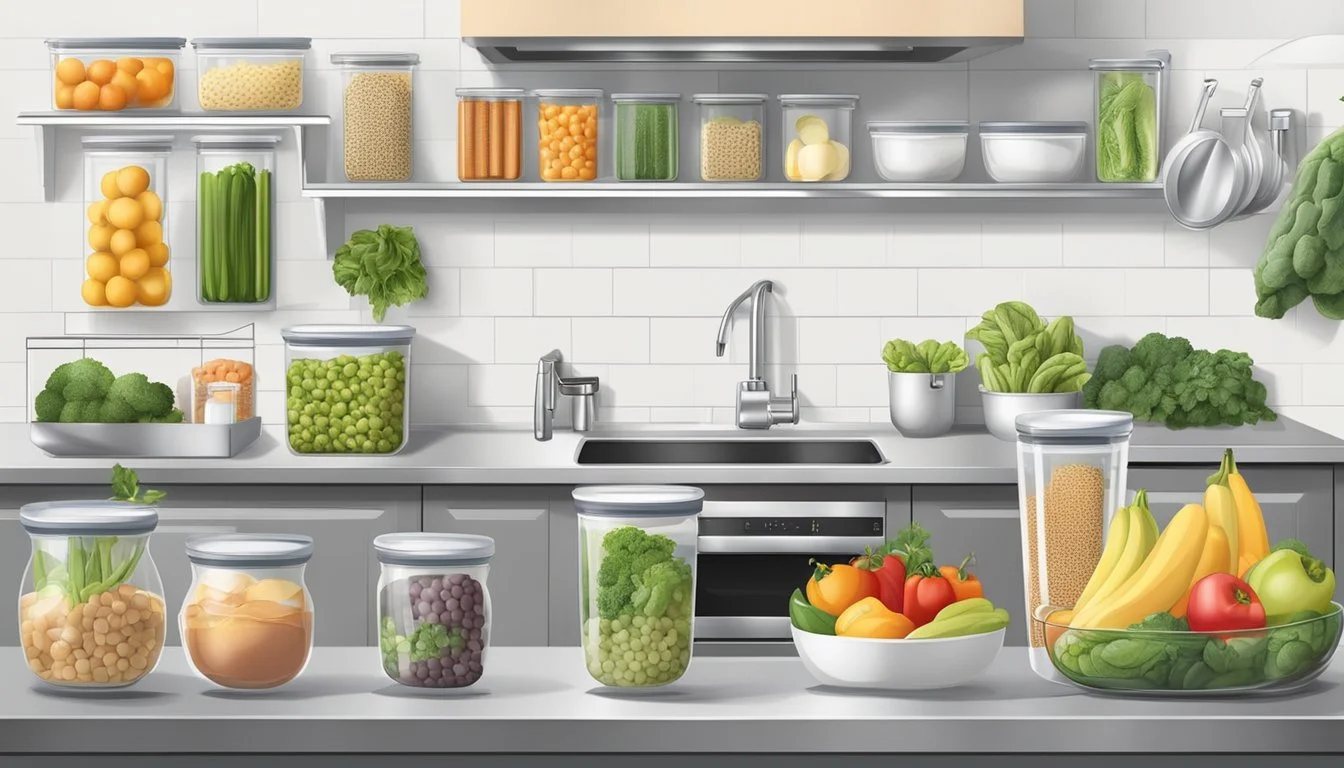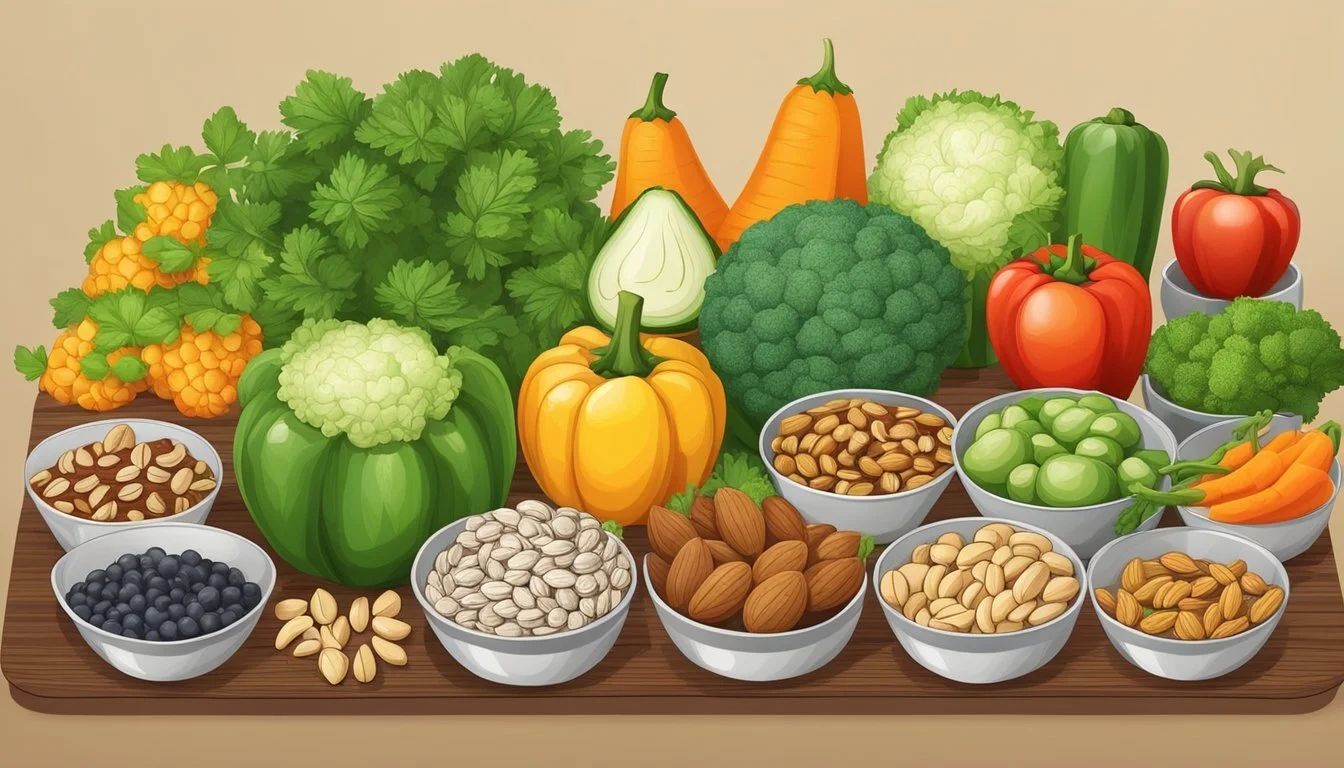Organizing Your Kitchen for a Pegan Diet
Streamlined Setup for Healthy Eating
Embracing a Pegan diet, a term coined by Dr. Mark Hyman, melds the principles of vegan and Paleo dietary frameworks into a cohesive eating lifestyle. This diet emphasizes nutrient-dense, whole foods with a strong foundation in plant-based choices, complemented by a modest intake of high-quality proteins and fats. Organizing a kitchen to accommodate the Pegan Diet means prioritizing space for fruits and vegetables, lean meats sourced from grass-fed animals, and whole grains, while steering clear of processed foods and refined sugars.
The focal point of a Pegan kitchen revolves around freshness and minimal processing. As such, organizing should facilitate easy access to fresh produce, nuts (What wine goes well with nuts?), seeds, and smaller portions of animal protein. Grains and legumes, though present, are enjoyed in control, underscoring the Pegan diet's mantra of balance. Storage solutions must cater to an array of fresh ingredients that are central to the diet, ensuring a range of colors and nutrients are at hand.
Streamlining a kitchen for Pegan-friendly cooking entails a layout where the staples such as black rice, quinoa, and various nuts and seeds are readily available. Sections of the kitchen can be dedicated to the assortment of vegetables and fruits crucial to the diet, while a designated preparation area aids in the efficient assembly of meals. This approach to kitchen organization not only supports the Pegan lifestyle but also inspires creativity in combining Paleo tenets with vegan elements for a synergistic approach to health and well-being.
Understanding the Pegan Diet
The Pegan Diet merges the principles of the Paleo and Vegan diets, focusing on whole foods to foster optimal health, regulate blood sugar, and reduce inflammation.
The Principles of Peganism
The core of the Pegan Diet lies in its emphasis on whole and unprocessed foods, with a spotlight on fruits and vegetables. The diet encourages a high intake of these plant-based foods, expecting them to form the majority of one's plate. While it aligns with the Paleo Diet in its support for lean meats and fish as protein sources, it simultaneously draws from the Vegan Diet by substantially limiting dairy and grain products.
Key components include:
Fruits and Vegetables: Uptake is encouraged, focusing on low-glycemic fruits to stabilize blood sugar levels.
Proteins: Small portions of sustainably sourced animal proteins.
Grains and Legumes: Constraints on intake, favoring low quantities of specific types such as quinoa.
Nuts and Seeds: Included for their healthy fats and protein.
Healthy Fats: Emphasis on fats from avocados, nuts, and omega-3s.
Pegan Diet: Combining Paleo and Vegan Concepts
The Pegan Diet is distinguished by its unique combination of the Paleo Diet's focus on high-quality meats and avoidance of processed foods, with the Vegan Diet's restrictions on animal products. It includes:
Meat: While meat is consumed, it takes a side role—more like a condiment than a centerpiece.
Dairy Alternatives: Non-dairy milks such as almond or coconut milk are preferred.
Sustainability: The choice of all foods, particularly animal proteins, considers environmental impact and ethical sourcing.
Known benefits of this diet are its potential to reduce inflammation and assist in maintaining healthy blood sugar levels. This arises from its balance of macronutrients and its low glycemic load.
Designing Your Pegan Kitchen Space
When adopting a Pegan diet, which combines the principles of Paleo and vegan diets, one must prioritize the organization of whole foods and minimize processed items. Planning your kitchen space with an emphasis on the essentials for a Pegan diet will streamline your culinary processes.
Essential Equipment for a Pegan Kitchen
A Pegan diet emphasizes the consumption of fresh vegetables, fruits, lean proteins, nuts, and seeds while avoiding processed foods and most grains. It is critical that the kitchen is equipped with the right tools to handle these ingredients.
Food Storage: Use clear, airtight containers for nuts and seeds to ensure freshness and prevent oxidation. Opt for glass over plastic to avoid contaminants.
Blenders and Processors: A high-powered blender or food processor is indispensable for making smoothies, nut butters, and seed-based dressings.
Cutting Boards and Knives: Multiple cutting boards designated for produce, meats, and nuts help avoid cross-contamination, and a set of sharp knives are essential for efficient prep.
Cookware: Opt for a versatile set of cookware—stainless steel or cast-iron skillets, pots, and a large stockpot for soups and stews made with whole foods.
Organizing for Efficiency
To maximize efficiency and ease of use in a Pegan kitchen:
Categorization: Dedicate sections of your kitchen to Pegan staples. Store whole foods like vegetables and fruits in easily accessible areas, such as the lower shelves of the fridge or a dedicated produce drawer.
Minimizing Grains: Since grains are consumed minimally on a Pegan diet, designate a small, specific cabinet or shelf for the limited varieties you may keep, such as quinoa or wild rice.
Containers and Labeling: Utilize containers with clear labeling for seeds and nuts. Allocate drawer or shelf space that allows for easy grabbing without sifting through miscellaneous items.
By properly equipping and organizing the kitchen for a Pegan diet, one promotes a seamless experience in preparing nutritious meals. This setup also helps to maintain the integrity of whole foods and supports the overall goal of healthful eating.
Stocking the Pegan Pantry and Fridge
The implementation of a Pegan diet requires a kitchen stocked with specific items that align with its principles, emphasizing whole, plant-based foods while including high-quality proteins and fats.
Pegan-Friendly Foods
In a Pegan diet, the emphasis is on high-quality protein sources, healthy fats, and low-glycemic fruits and vegetables. One will focus on integrating nuts, seeds, fruits, and non-starchy vegetables, which are nutrient-dense and fiber-rich.
Proteins and Fats:
Seeds: chia, flaxseed, hemp
Nuts: almonds, walnuts, macadamia
Healthy fats: avocados, coconut products
Low-Glycemic Fruits:
Berries: strawberries, raspberries
Other fruits: green apples, pears
Non-Starchy Vegetables:
Leafy greens: spinach, kale
Cruciferous vegetables: broccoli, cauliflower
Pegan Pantry Essentials
The pantry of a Pegan diet adherent is strategically stocked with whole and minimally processed ingredients. These essentials serve as the basis for crafting nourishing meals that adhere to Pegan diet guidelines.
Grains:
Gluten-free options: quinoa, wild rice
Legumes:
Varieties: lentils, chickpeas (limited quantities)
Nuts and Seeds:
Almonds, walnuts, pumpkin seeds
Healthy Fats:
Oils: extra-virgin olive oil, avocado oil
Vinegars/sauces: apple cider vinegar, tamari
Starchy Vegetables:
Sweet potatoes (limited quantities)
Fresh Produce Selection
The refrigerator in a Pegan-friendly kitchen predominantly stores a variety of fresh produce, supporting the diet's plant-centric approach. Care is taken to preserve the nutrients and taste of these perishable items.
Vegetable Storage:
Crisper drawer for greens and cruciferous vegetables
Cool, dry place for starchy vegetables like sweet potatoes
Fruit Storage:
Berries in containers with airflow
Citrus and apples in low humidity drawers
Preparing Pegan Meals
When committing to a Pegan diet, meal preparation involves careful consideration of nutritional balance and the integration of robust flavors without additives like refined sugar.
Balancing Your Plate: Proportions and Portions
For a Pegan diet, one must ensure the plate contains adequate amounts of proteins, healthy fats, and fiber. Here’s a quick reference to portioning these components:
Protein: A small portion of the plate, about 25%, should consist of protein. Ideal sources include grass-fed meats, sustainably caught fish, and, occasionally, plant-based proteins like lentils.
Healthy Fats: Around 25%-35% of the meal should come from fats—think avocado, nuts, seeds, and oils such as olive and avocado oil. Use a variety of these to meet your daily fat intake needs.
Fiber: The remaining half of the plate should be fiber-rich vegetables and some fruits, emphasizing leafy greens and other non-starchy options to create volume and nutrient density.
Breakfast Example:
Food Group Portion Examples Protein 25% Poached eggs, smoked salmon (What wine goes well with salmon?) Healthy Fats 30% Avocado slices, chia seeds Fiber 45% Sautéed spinach, sliced bell peppers
Snacks:
Mixed nuts (almonds, walnuts)
Sliced vegetables with guacamole
Fresh berries with a dab of coconut butter
Creating Flavorful Pegan Recipes
To make Pegan meals appealing, one must utilize natural seasonings and cooking techniques that enhance the intrinsic flavors.
For instance, roasting cauliflower florets brings out a nutty sweetness, which complements the mellow coconut milk in cauliflower and potato curry soup. Incorporating herbs like cilantro or basil provides fresh accents without relying on added sugars.
Dinner Recipe Tip: Creating stews with beef and bold spices such as cumin and coriander not only provide the needed protein but also infuse the meal with aromatic flavors often found in Pegan-friendly recipes.
Remember, while sugars are to be limited within the Pegan diet, natural sweetness from whole fruits can be used judiciously to balance the palate in dishes like kale and apple salad, which pairs exquisitely with pan-seared salmon providing a robust dinner option.
Understanding and Selecting Proteins
Proteins play a crucial role in a Pegan diet, where they are selected with a focus on sustainability, animal welfare, and health benefits. The Pegan diet prioritizes high-quality proteins in moderate amounts from both animal and plant sources.
Sustainably Raised Meats and Poultry
In organizing a Pegan kitchen, chicken and other meats should be chosen with sustainability in mind. Sustainable choices include:
Grass-fed meats
Pasture-raised poultry
The emphasis is on smaller portions, typically 4 to 6 ounces per meal, ensuring the meat is an accompaniment rather than the centerpiece.
The Role of Fish and Seafood
Fish and seafood are integral to a Pegan diet, offering high-quality protein and essential omega-3 fatty acids. Key points include:
Opting for low-mercury fish such as salmon, sardines, and trout.
Ensuring seafood is wild-caught or sustainably farmed.
Including a variety of fish and seafood can help lower blood sugar levels and support heart health.
Plant-based Proteins in a Pegan Diet
Plant-based proteins provide essential nutrients while supporting a Pegan lifestyle. The Pegan diet includes:
Legumes such as lentils, but in limited quantities due to their density in carbohydrates.
Tofu and other soy products, which are seen as healthy protein alternatives.
Eggs, another protein staple, should ideally come from pasture-raised chickens. Including a diversity of plant-based proteins ensures that one gets all essential amino acids.
Navigating Fats and Oils
In a Pegan diet, the fats and oils one chooses play a critical role in overall health, striking a balance between cooking stability and nutritional value.
Choosing Healthy Fats
Healthy fats are a cornerstone of the Pegan Diet. They should focus on unsaturated fats, which include both monounsaturated and polyunsaturated fats. These can be found in a variety of foods and are vital for brain function and reducing inflammation. Key options include:
Avocado: A versatile source of monounsaturated fats.
Nuts and seeds: Such as walnuts and flax seeds, known for their omega-3 content.
Fatty fish: Like salmon and mackerel that provide essential omega-3 fatty acids.
It's important for individuals to incorporate these unsaturated fats daily to reap the benefits.
Identifying Oils for Cooking and Dressings
When it comes to cooking and dressings, the Pegan diet endorses oils with high levels of unsaturated fats while maintaining a low smoking point to preserve nutritional integrity.
Olive oil:
For Dressings: Extra virgin olive oil is ideal for salad dressings and for drizzling over dishes, as it is rich in monounsaturated fats and adds flavor.
For Cooking: Look for pure or light olive oil, as it has a higher smoke point and is better suited for cooking.
Coconut oil:
While it is higher in saturated fat, coconut oil can be used sparingly in cooking due to its medium-chain triglycerides that may offer health benefits.
Selecting the right oils and integrating healthy fats from foods like avocados helps align one's dietary habits with the principles of the Pegan diet, supporting overall wellness.
Pegan Diet Benefits and Considerations
Embracing a pegan diet can lead to numerous health benefits, though one must be aware of potential challenges. A mindful approach can help individuals navigate and optimize this dietary pattern.
Advantages for Health and Wellness
Weight Loss: The pegan diet's high intake of fruits and vegetables, combined with lean proteins, supports a nutritious and balanced approach to weight loss. Low-glycemic fruits such as cherries and apples are emphasized, which may help in managing blood sugar levels.
Heart Health: Since the pegan diet includes healthy fats and encourages the consumption of omega-3 rich foods, such as wild salmon, it can contribute to improved heart health.
Nutrient-Rich: A varied selection of fruits, vegetables, and protein sources ensures a diet full of essential vitamins and minerals.
Minimized Processed Foods: The pegan diet advises against processed foods and additives, helping individuals consume more whole, unrefined foods.
Potential Challenges and How to Overcome Them
Dairy and Grain Limitations: The pegan diet restricts dairy intake and limits grain consumption. One should opt for unsweetened nut milk as a dairy alternative and choose nutrient-dense grains like quinoa and amaranth to stay within the dietary guidelines.
Maintaining Diversity: Ensuring a sufficient intake of all essential nutrients can be challenging due to dietary restrictions. Individuals should focus on a wide range of vegetables and lean proteins to overcome this.
Cost and Accessibility: The recommendation for sustainably sourced proteins and organic produce may result in higher costs. Shop local farmers’ markets or consider subscribing to a community-supported agriculture (CSA) box to mitigate expenses.
By understanding the benefits and potential obstacles of the pegan diet, one can organize their kitchen to better support their dietary choices. A well-thought-out approach to meal planning and grocery shopping is key to maintaining this lifestyle.
Shopping and Dining Out Pegan-Style
Adhering to a Pegan diet requires strategic shopping and savvy menu selections when dining out. The focus is on obtaining high-quality, whole foods and avoiding processed items while maintaining a balance between plant-based and responsibly sourced animal products.
Shopping Tips for Pegan Dieters
When shopping for a Pegan diet, consumers should prioritize organic produce to minimize exposure to pesticides. A core principle of the diet is to seek out items that are both nutrient-dense and gluten-free, as it leans towards minimal consumption of grains. The Pegan diet encourages the purchase of grass-fed meats due to their higher omega-3 content and sustainable seafood to support environmental health.
Fruits and Vegetables: Opt for organic options, especially for those listed on the "Dirty Dozen."
Meats: Choose grass-fed beef and pasture-raised chicken when available.
Seafood: Look for labels that indicate sustainable practices.
Legumes and Grains (in moderation): Select non-GMO and organic lentils, black rice, quinoa, and other approved grains.
Dairy and Eggs: Go for alternatives such as unsweetened almond milk and organic eggs.
Navigating Restaurant Menus
Pegan dieters should approach dining out with a strategy to ensure their meals align with the diet's principles. It is vital to enquire about the sourcing of the dishes, aiming to select those that contain grass-fed meats and organic ingredients. Foods that are labeled as gluten-free are often a safe choice, provided they consist of whole foods and not processed substitutes.
Appetizers: Begin with a salad containing a variety of organic vegetables.
Main Courses: Request dishes that feature small portions of grass-fed meats or sustainable fish.
Sides: Steer clear of processed items, opting instead for side dishes like roasted organic vegetables.
Desserts: Conclude the meal with fruit-based options, avoiding recipes with added sugars or artificial ingredients.
FAQs and Common Myths about the Pegan Diet
What is the Pegan Diet?
The Pegan Diet is a hybrid approach that combines principles from paleo and vegan diets. It emphasizes whole foods, with a focus on low-glycemic fruits, vegetables, lean meats, and plant-based proteins.
Can I consume dairy on the Pegan Diet?
No, dairy is generally avoided. However, dairy alternatives without added sugar, such as unsweetened nut milk or coconut milk, can be consumed.
Is sugar allowed in the Pegan Diet?
Refined sugars should be eliminated. Natural sweeteners like raw honey or maple syrup can be used sparingly.
Common Myths Facts Beans and legumes are a large part of the diet. Actually, they are limited due to their high lectin content. All grains are off limits. While one should avoid gluten-containing grains, small amounts of gluten-free and whole grains may be included. The Pegan Diet is high in meats. It recommends moderate portions of sustainably raised or grass-fed meats. It's an all-or-nothing diet. The Pegan Diet is flexible and can be adjusted based on individual needs and responses.
Are legumes and beans banned from the Pegan Diet?
They are not banned but should be eaten in limited quantities. They recommend soaking and sprouting to reduce lectin content.
Do you have to eat grass-fed, organic meats?
Ideally, one should choose lean, sustainably raised meats to reduce exposure to antibiotics and hormones.
What about gluten-free diets?
The Pegan Diet naturally aligns with gluten-free requirements as it eliminates gluten-containing grains in favor of those that are more nutrient-dense.
Are whole grains allowed?
Yes, but in small amounts. The focus remains on the nutritional quality and density of the grains chosen.









